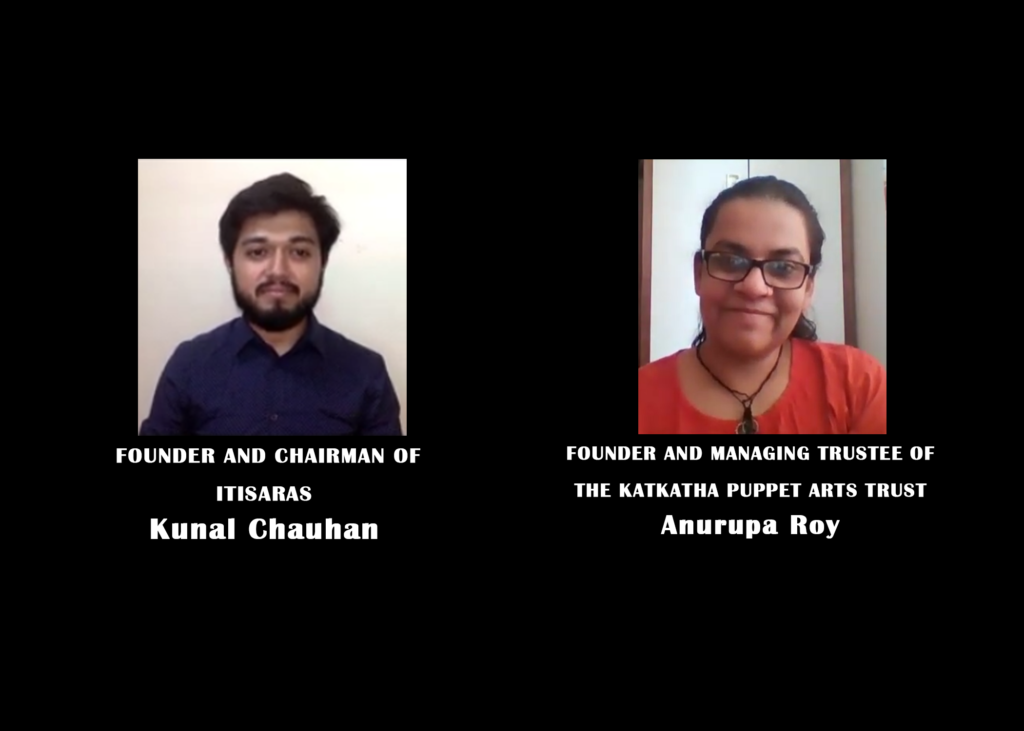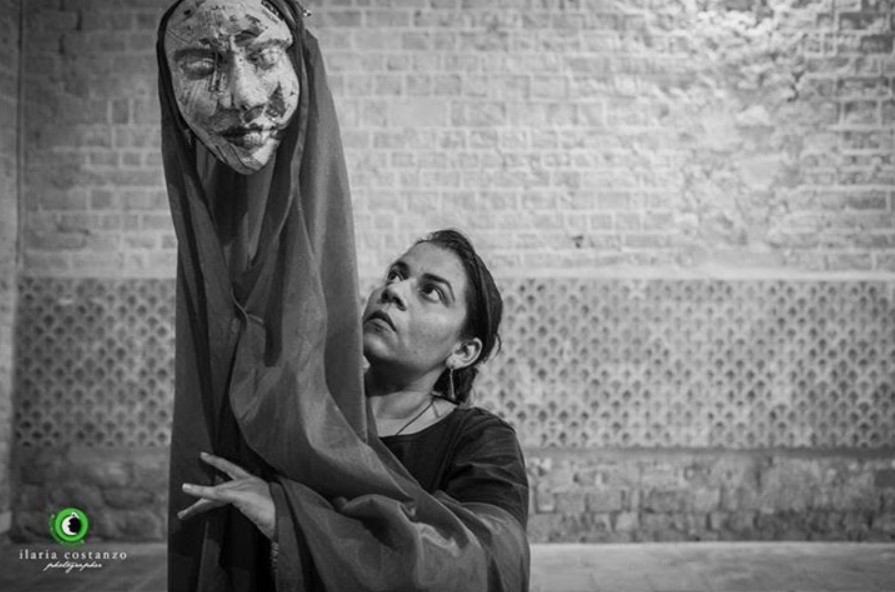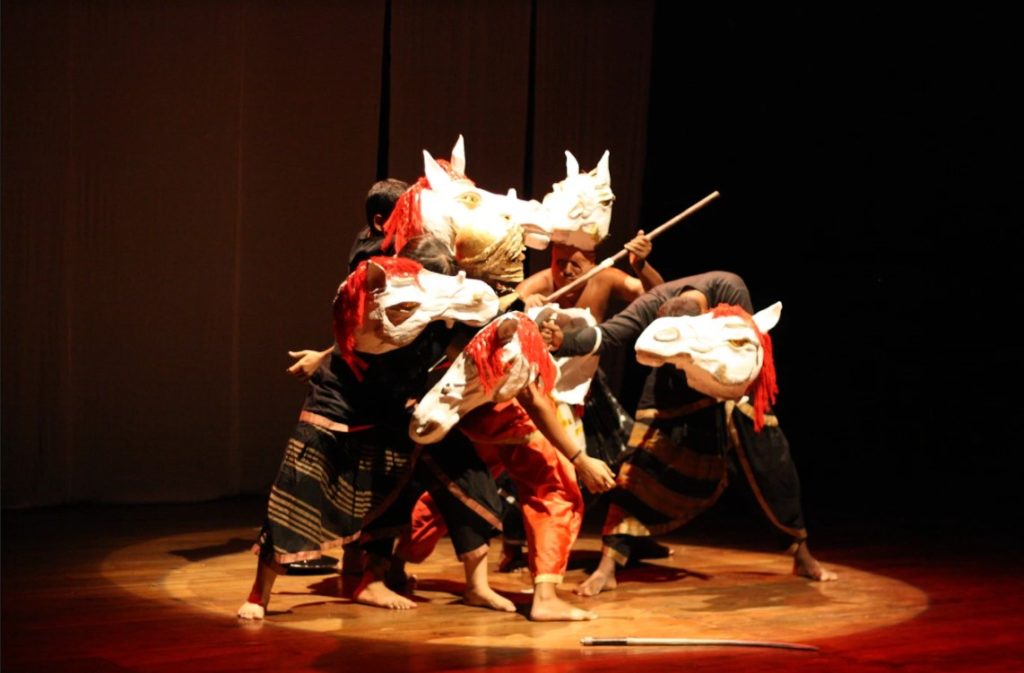

Anurupa Roy is a puppeteer, puppet theatre director and puppet designer. She is the founder and managing trustee of the Katkatha Puppet Arts Trust, a puppet theatre group based in Delhi, India since 1998. She has a diploma in Puppet theatre from DI (Dramatiska Institutet) for Film, TV, Drama and Radio, at Stockholm University, Sweden and has been trained in traditional glove puppetry from the School of Traditional Glove Puppetry in Naples, Italy under Bruno Leone in 2002. She is a recipient of the Ustad Bismillah Khan Yuva Puraskar, 2007, a national award for contribution to puppet theatre by the Ministry of Culture. She is currently the Trustee of UNIMA India, now known as UNIMA Puppeteers Trust, the Indian Chapter of the Union Internationale de la Marionette.
First, in the interview, Anurupa explains how her fascination with puppets— the land of non-living which gives one a lot of potential into imagining other worlds— began as she performed for children and subsequently, the age of her audience grew along with her. The birth of her company was the result of this attraction to the world of the non-living, what it conveys and the daring attitude of a university student. This was enhanced when she realised that working with the inanimate was a sole projection of oneself while in the case of theatre actors, the audience listens to both, the actor as well as the character.
Moving further, we got to learn about puppet theatre as one of the oldest surviving art forms of the subcontinent. Anurupa explained through the examples of Yakshagana puppeteers in Karnataka and those in Bengal performing the local folk, Jatra, with puppets; that the concept in the east of the world (especially South & southeast Asia) was of an all in one complete performer who performed all the roles like that of a dancer, musician, puppeteer, a storyteller. It was only a recent phenomenon that artists started identifying themselves with a singular part of the performance. Accordingly, as soon as the split happened, for instance, labelling certain art forms as classical while others as folk, through the politics of culture along with the concept of patronage (government): puppet theatre with dolls was classified as children’s theatre. However, in India, puppet shows were always about the community, performed as all-night shows, the theme shifting within the show according to the crowd as children drifted to sleep and the adult philosophical portion started. This led us to the key difference between cinema and live performances, where the need to engage with & perform for the audience dominates in the latter.
Though, it’s an agreeable fact that puppet theatre is of the margins as a lot of puppeteers were also shamans, witch doctors, etc., it’s also noteworthy that, caste being a nebulous identity, the performing artists (belonging to lower castes like leather shadow puppeteers) were allowed into the temples. Nonetheless, puppetry, though marginalised in the contemporary world, is definitely not a dying art form.

Giving us an insight into the traditions of puppet theatre, Anurupa elucidated on the various occasions it was performed on: the birth of a child, coming of age ceremony, marriages, death, etc; the choice of script depending on the context and yet others were always performed in a temple. The status and roles are different across South Asia, as, for instance, a puppeteer in Indonesia is a wise influencer, celebrity or a master entertainer, respected everywhere. The context here is crucial, that it has always been a socio-religious cultural practice unlike modern theatre, an art form supposed to be performed in an auditorium. The assumption that there’s a kind of novelty and experimentation happening in modern theatre unlike traditional puppetry, isn’t true as constant innovation & improvisation is one of the major reasons for its survival over almost 3000 years. Therefore, the basic differentiating point is the nature of the contract between the host and the audiences, which is starkly distinct in modern theatre and traditional puppetry. Another distinction is the aesthetics, the generational passing on of knowledge in traditional art forms in contrast to modern, where it claims to break away, forgetting to acknowledge that every idea is the result of inspiration from something existing and the only real new introduction is the technological innovation. Thus, leading us to question whether anything ever is completely original?
Referring to the current unprecedented circumstances due to Covid 19, Anurupa explained the activities of her union as they worked to compile a list of puppeteers across community, state, region and their differing degrees of the distressed situation over the last two years of several lockdowns. As puppetry is not a full-time occupation in India, the circumstances are alarming for the landless puppeteers, residing in cities & urban slums, dependent on day to day earnings or the traditional audiences. The initial SOS call for immediate help was from the Kathputalivalas (like a puppeteer community in Shadipur) during the first lockdown, who had run out of all their earnings within 4-5 days. While the level of severity differs in each state, the communities residing in places like West Bengal, which was also hit by two cyclones, is the worst as they even lost their homes along with livelihood. Here, researchers like Sudip Gupta, a puppeteer himself, depicted the shift of traditional performing artists to contractural jobs through a comparative study done on the effects of natural disasters on folk artists in West Bengal. Another example being of shadow puppet community in Tamil Nadu, who despite owning land & growing rice, doesn’t have enough money to buy vegetables & other food items, thus surviving on rice & salt. As part of UNIMA, one of the various projects is an ongoing fundraiser through spreading behind the stage short videos relating to their lifestyles or maintenance of puppets, etc about which there is little or zero existing awareness outside the puppetry community. Another has been going on for two years, by puppeteers like Sudip Gupta & Partho Paul, supporting puppetry families by giving them a monthly stipend to continue creating work at home, so that they don’t completely leave the scene.
Coming to the contemporary puppet theatres that performed shows at various kinds of cultural events, school shows, weddings, etc., the halt of all such events due to the pandemic has completely slashed away a large chunk of their income. As for the Katkatha itself, the mainstay was touring festivals among other varieties of live shows in collaboration with schools, urban slums, communities, etc. With the complete shutdown of the human interface, 95% of the work is being done online, implying quick inventions of innovative ways to work online. In other words, striving to maintain a compromise between physical & online, like in the case of children, to avoid them from becoming allergic to the art forms. Some examples of the recent online work by the company are, ‘The Girl in the Pink Frock’ (based on worker’s migration during lockdown), ‘Tillapur ka Rakshas’ (coproduced with a German company). While nothing could be compared to the traditional live performances, new opportunities are also being created through online mode, making it possible to work with people across the globe. The cost is also reduced online, giving access to people otherwise unable to reach physically.
As in regards to government aid, while there hasn’t been any large scale help from the Ministry of Culture, several state governments and MLAs on an individual level have extended a helping hand according to their capacity. While Rajasthan govt. promoted puppetry through setting up a shopping platform on their tourism website, Eastern Zonal Cultural (EZC) Center organised a digital online puppet festival in West Bengal through a collection of video clips, yet other state governments came up with ration plans. At the policy level, much improvement is necessary, which is possible with some effort as we already have institutions in a place like Sangeet Natak Academy (the only place having archival material on all 18 forms of traditional puppetry). This is a perfect opportunity to create new incentives and innovative ways to employ such artists, which will also help them keep their dignity instead of making pity donations. The private sector has come up with numerous creative solutions through fundraisers, grants, etc encouraging young & upcoming artists.
On a constitutional level, Anurupa concluded, we have some wonderful art policies like for novice theatre producers, support structure for transmission through guru-shishya parampara, grant systems, pension programmes, research grants; the only thing needed is intention and implementation. Lack of proper ground research, decent census, accurate knowledge, etc., is contributing to the endangerment of puppet theatre. There is a dire need for persons interested in culture and with a will to make a difference on the ground level. The audience today is the real patron who could help keep art forms alive. And it’s encouraging when laypersons these days come forward and portray their demands for performances to motivate the artists. Thus, the future of all funding is collective, which will also have the positive side effect of them becoming more invested in the survival of these art forms. Unified efforts from the government, audience, organisations, etc are the only way to make sure that puppetry and puppet theatre is revived as a popular art form.
To know more about how the pandemic has impacted the performing arts sector, especially puppet theatre please watch our interview with Anurupa Roy.
We, at Itisaras, believe that awareness and action are integral for change, and for the same we have launched a petition on change.org that urges the Ministry of Culture to extend institutional support to the people of the Performance Arts sector. Please join us and sign the petition – http://chng.it/zhFTnGdPMm



